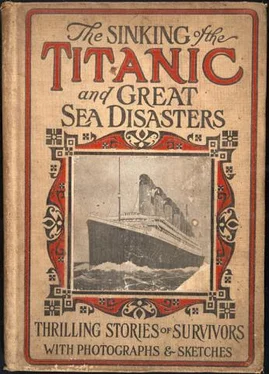Logan Marshall - Sinking of the Titanic and Great Sea Disasters
Здесь есть возможность читать онлайн «Logan Marshall - Sinking of the Titanic and Great Sea Disasters» весь текст электронной книги совершенно бесплатно (целиком полную версию без сокращений). В некоторых случаях можно слушать аудио, скачать через торрент в формате fb2 и присутствует краткое содержание. Год выпуска: 1912, Жанр: Прочая документальная литература, на английском языке. Описание произведения, (предисловие) а так же отзывы посетителей доступны на портале библиотеки ЛибКат.
- Название:Sinking of the Titanic and Great Sea Disasters
- Автор:
- Жанр:
- Год:1912
- ISBN:нет данных
- Рейтинг книги:4.5 / 5. Голосов: 2
-
Избранное:Добавить в избранное
- Отзывы:
-
Ваша оценка:
- 100
- 1
- 2
- 3
- 4
- 5
Sinking of the Titanic and Great Sea Disasters: краткое содержание, описание и аннотация
Предлагаем к чтению аннотацию, описание, краткое содержание или предисловие (зависит от того, что написал сам автор книги «Sinking of the Titanic and Great Sea Disasters»). Если вы не нашли необходимую информацию о книге — напишите в комментариях, мы постараемся отыскать её.
’s demise!
Sinking of the Titanic and Great Sea Disasters — читать онлайн бесплатно полную книгу (весь текст) целиком
Ниже представлен текст книги, разбитый по страницам. Система сохранения места последней прочитанной страницы, позволяет с удобством читать онлайн бесплатно книгу «Sinking of the Titanic and Great Sea Disasters», без необходимости каждый раз заново искать на чём Вы остановились. Поставьте закладку, и сможете в любой момент перейти на страницу, на которой закончили чтение.
Интервал:
Закладка:
“Did you or Bride send any message declaring that the Titanic was being towed into Halifax?”
“No, sir,” said the witness, with emphasis.
In an effort to determine whether the signal “C. Q. D.” might not have been misunderstood by passing ships, Senator Smith called upon Mr. Marconi.
“The ‘C. Q.,’” said Marconi, “is an international signal which meant that all stations should cease sending except the one using the call. The ‘D.’ was added to indicate danger. The call, however, now has been superseded by the universal call, ‘S. O. S.’”
Harold S. Bride, the sole surviving operator of the Titanic, was then called.
Bride said he knew the Frankfurt was nearer than the Carpathia when he called for assistance, but that he ceased his efforts to communicate with the former because her operator persisted in asking, “What is the matter?” despite Bride’s message that the ship was in distress.
Time after time Senator Smith asked in varying forms why the Titanic did not explain its condition to the Frankfurt.
“Any operator receiving ‘C. Q. D.’ and the position of the ship, if he is on the job,” said Bride, “would tell the captain at once.”
Marconi again testified to the distress signals, and said that the Frankfurt was equipped with Marconi wireless. He said that the receipt of the signal “C. Q. D.” by the Frankfurt’s operator should have been all-sufficient to send the Frankfurt to the immediate rescue.
Under questioning by Senator Smith, Bride said that undoubtedly the Frankfurt received all of the urgent appeals for help sent subsequently to the Carpathia.
The first witness when the investigation was resumed in Washington on April 22d was P. A. S. Franklin, vice-president of the International Mercantile Marine Company.
Franklin testified that he had had no communication with Captain Smith during the Titanic’s voyage, nor with Ismay, except one cable from Southampton.
Senator Smith then showed Mr. Franklin the telegram received by Congressman Hughes, of West Virginia, from the White Star Line, dated New York, April 15th, and addressed to J. A. Hughes, Huntington, W. Va., as follows:
“Titanic proceeding to Halifax. Passengers probably land on Wednesday. All safe.
(Signed) “THE WHITE STAR LINE.”“I ask you,” continued the senator, “whether you know about the sending of that telegram, by whom it was authorized and from whom it was sent?”
“I do not, sir,” said Franklin. “Since it was mentioned at the Waldorf Saturday we have had the entire passenger staff examined and we cannot find out.”
Asked when he first knew that the Titanic had sunk, Franklin said he first knew it about 6.27 P.M., Monday.
Mr. Franklin then produced a thick package of telegrams which he had received in relation to the disaster.
“About twenty minutes of two on Monday morning,” said he, “I was awakened by a telephone bell, and was called by a reporter for some paper who informed me that the Titanic had met with an accident and was sinking. I asked him where he got the information. He told me that it had come by wireless from the steamship Virginian, which had been appealed to by the Titanic for aid.”
Mr. Franklin said he called up the White Star docks, but they had no information, and he then appealed to the Associated Press, and there was read to him a dispatch from Cape Race advising him of the accident.
“I asked the Associated Press,” said Mr. Franklin, “not to send out the dispatch until we had more detailed information, in order to avoid causing unnecessary alarm. I was told, however, that the story already had been sent.”
The reassuring statements sent out by the line in the early hours of the disaster next were made the subject of inquiry.
“Tell the committee on what you based those statements,” directed Senator Smith.
“We based them on reports and rumors received at Cape Race by individuals and by the newspapers. They were rumors, and we could not place our finger on anything authentic.”
“At 6.20 or 6.30 Monday evening,” Mr. Franklin continued, “a message was received telling the fateful news that the Carpathia reached the Titanic and found nothing but boats and wreckage; that the Titanic had foundered at 2.20 A.M. in 41.16 north, 50.14 west; that the Carpathia picked up all the boats and had on board about 675 Titanic survivors—passengers and crew.
“It was such a terrible shock that it took me several moments to think what to do. Then I went downstairs to the reporters, I began to read the message, holding it high in my hand. I had read only to the second line, which said that the Titanic had sunk, when there was not a reporter left—they were so anxious to get to the telephones.
“The Titanic’s equipment was in excess of the law,” said the witness. “It carried its clearance in the shape of a certificate from the British Board of Trade. I might say that no vessel can leave a British port without a certificate that it is equipped to care for human lives aboard in case of accident. It is the law.”
“Do you know of anyone, any officer or man or any official, whom you deem could be held responsible for the accident and its attendant loss of life?”
“Positively not. No one thought such an accident could happen. It was undreamed of. I think it would be absurd to try to hold some individual responsible. Every precaution was taken; that the precautions were of no avail is a source of the deepest sorrow. But the accident was unavoidable.”
J. B. Boxhall, the fourth officer, was then questioned.
“Were there any drills or any inspection before the Titanic sailed?” he was asked.
“Both,” said the witness. “The men were mustered and the life-boats lowered in the presence of the inspectors from the Board of Trade.”
“How many boats were lowered?”
“Just two, sir.”
“One on each side of the ship?”
“No, sir. They were both on the same side. We were lying in dock.”
The witness said he did not know whether the lowering tackle ran free or not on that occasion.
“In lowering the life-boats at the test, did the gear work satisfactorily?”
“So far as I know.”
In lowering a life-boat, he said, first the boat has to be cleared, chocks knocked down and the boat hangs free. Then the davits are screwed out to the ship’s side and the boat lowered.
At the time of the tests all officers of the Titanic were present.
Boxhall said that under the weather conditions experienced at the time of the collision the life-boats were supposed to carry sixty-five persons. Under the regulations of the British Board of Trade, in addition to the oars, there were in the boats water breakers, water dippers, bread, bailers, mast and sail and lights and a supply of oil. All of these supplies, said Boxhall, were in the boats when the Titanic left Belfast. He could not say whether they were in when the vessel left Southampton.
“Now,” repeated Senator Smith, “suppose the weather was clear and the sky unruffled, as it was at the time of the disaster, how many would the boat hold?”
“Really, I don’t know. It would depend largely upon the people who were to enter. If they did as they were told I believe each boat could accommodate sixty-five persons.”
Boxhall testified to the sobriety and good habits of his superior and brother officers.
Boxhall said he went down to the steerage, inspected all the decks in the vicinity of where the ship had struck, found no traces of any damage and went directly to the bridge and so reported.
Читать дальшеИнтервал:
Закладка:
Похожие книги на «Sinking of the Titanic and Great Sea Disasters»
Представляем Вашему вниманию похожие книги на «Sinking of the Titanic and Great Sea Disasters» списком для выбора. Мы отобрали схожую по названию и смыслу литературу в надежде предоставить читателям больше вариантов отыскать новые, интересные, ещё непрочитанные произведения.
Обсуждение, отзывы о книге «Sinking of the Titanic and Great Sea Disasters» и просто собственные мнения читателей. Оставьте ваши комментарии, напишите, что Вы думаете о произведении, его смысле или главных героях. Укажите что конкретно понравилось, а что нет, и почему Вы так считаете.












